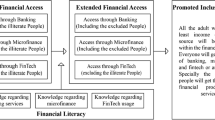Abstract
This study examines the cost efficiency of 39 microfinance institutions across Africa, Asia and the Latin America using non-parametric data envelopment analysis. Our findings show non-governmental microfinance institutions particularly; under production approach, are the most efficient and this result is consistent with their fulfillment of dual objectives: alleviating poverty and simultaneously achieving financial sustainability. However, bank-microfinance institutions also outperform in the measure of efficiency under intermediation approach. This result reflects that banks are the financial intermediaries and have access to local capital market. It may be possible that bank-microfinance institutions may outperform the non-governmental microfinance institutions in the long run.
Similar content being viewed by others
References
Aly H. Y., Grabowski R., Pasurka C., Rangan N. (1990) Technical, scale and allocative efficiencies in U.S. banking: an empirical investigation. Review of Economics and Statistics 72(2): 211–218
Avkiran N. K. (1999) Technical evidence on efficiency gains: The role of mergers and the benefits to the public. Journal of Banking and Finance 23: 991–1013
Banker R. D., Charnes A., Cooper W. W. (1984) Some models for estimating technical and scale inefficiencies in data envelopment analysis. Management Science 30(9): 1078–1092
Baumann T. (2005) Pro poor microcredit in South Africa: Cost efficiency and productivity of South African pro-poor microfinance institutions. Journal of Microfinance 7(1): 95–118
Berg S. A., Førsund F. R., Jansen E. S. (1991) Technical efficiency of Norwegian banks: The non-parametric approach to efficiency measurement. The Journal of Productivity Analysis 2: 127–142
Berg S. A., Førsund F. R., Hjalmarsson L., Souminen M. (1993) Banking efficiency in the Nordic countries. Journal of Banking and Finance 17: 371–388
Berger A., Humphrey D. B. (1992) Mega mergers in banking and the use of cost efficiency as an antitrust defense. Antitrust Bulletin 37: 541–600
Brau J. C., Woller G. M. (2004) Microfinance: A comprehensive review of the existing literature. Journal of Entrepreneurial Finance and Business Ventures 9: 1–26
Casu B., Molynuex P. A. (2003) Comparative study of efficiency in European banking. Applied Economics 35: 1865–1876
Charnes A., Cooper W. W. (1962) Programming with linear fractionals. Naval Research Quarterly 9: 181–186
Charnes A., Cooper W. W., Rhodes E. (1978) Measuring the efficiency of decision making units. European Journal of Operational Research 2(6): 429–444
Coelli, T. (1996). A guide to DEAP version 2.1: a data envelopment analysis (computer) program. Centre for efficiency and productivity analysis (CEPA). www.une.edu.au/econometrics/cepa.html. (accessed in Jan 2006).
Cooper W. W., Seifordc L. M., Tone K. (2000) Data envelopment analysis a comprehensive text with models, applications, references and DEA-solver software. Kluwer Academic Publishers, Boston
Desrochers, M., & Lamberte, M. (2003). Efficiency and expense preference behavior in Philippines’ cooperative rural banks. Centre interuniversitairesur les risque, les politiques economiques et l’emploi (CIRPÉE.) Cahier de recherche/Working paper 03-21.
Dusansky R., Wilson P. (1995) On the relative efficiency of alternative modes of producing a public sector output: The case of the developmentally disabled. European Journal of Operational Research 80: 608–618
Elyasiani E., Mehdian S. M. (1990) A nonparametric approach to measurement of efficiency and technological change: The case of large U.S. commercial banks. Journal of Financial Services Research 4: 157–168
Farrington, T. (2000). Efficiency in microfinance institutes. Microbanking Bulletin, 20–23.
Ferrier G. D., Lovell C. A. K. (1990) Measuring cost efficiency in banking: Econometric and linear programming evidence. Journal of Econometrics 46: 229–245
Fried H. O., Lovell C. A. K., Eeckaut P. V. (1993) Evaluating the performance of U.S. credit unions. Journal of Banking and Finance 17: 251–265
Fried H. O., Lovell C. A. K., Yaisawarng S. (1999) The impact of mergers on credit union service provision. Journal of Banking and Finance 23: 367–386
Guitierrez-Nieto B., Serrano-Cinca C., Molinero C. M. (2006) Microfinance institutions and efficiency. OMEGA, International Journal of Management Science 35(2): 131–142
Hassan M. K., Tufte D. R. (2001) The X-efficiency of a group based lending institution: The case of Grameen Bank. World Development 29: 1071–1082
Isik I., Hassan M. K. (2003) Financial deregulation and total factor productivity change: An empirical study of Turkish commercial banks. Journal of Banking and Finance 27: 1455–1485
Laeven, L. (1999). Risk and efficiency in East Asian banks. Policy Research. Working Paper 2255. The World Bank. Financial Sector Strategy and Policy Department.
Lafourcade, A., Isern, J., Mwangi, P., & Brown, M. (2005). Overview of the outreach and financial performance of microfinance institutions on Africa. www.mixmarket.org. (accessed in Jun. 2006).
Leon J. V. (2001). Decentralized efficient organizations of microfinance: The case of the Peruvian municipal banks. Working paper series. Wittenberg University, Ohio.
McCarty T.A., Yaisawarng S. (1993) Technical efficiency in New Jersey school districts. In: Fried H.O., Lovell C.A.K., Schmidt S.S. (eds) The measurement of productive efficiency techniques and applications. Oxford University Press, USA, pp 272–287
Maxwell S. (1999) The meaning and measurement of poverty. Overseas Development Institute Poverty Briefing 3: 1–6
Microbanking Bulletin. (2005). Performance and Transparency. A survey of microfinance in South Asia. The MIX market, www.mixmarket.org (accessed in Jun 2006).
Microbanking Bulletin. (2004). Benchmarking Latin American microfinance. The MIX Market, www.mixmarket.org. (accessed in Jan 2006).
Murdoch J. (2000) The microfinance schism. World Development 28: 617–629
Oral M., Yolalan R. (1990) An empirical study on measuring operating efficiency and profitability of bank branches. European Journal of Operational Research 46: 282–294
Pastor J. T., Lozano A., Pastor J. M. (2002) An efficiency comparison of European banking systems operating under different environmental conditions. Journal of Productivity Analysis 18: 59–78
Sherman H. D., Gold F. (1985) Bank branch operating efficiency. Evaluation with data envelopment analysis. Journal of Banking and Finance 9: 297–315
Woller G., Dunford C., Woodworth W. (1999) Where to microfinance. International Journal of Economic Development 1: 29–64
Author information
Authors and Affiliations
Corresponding author
Rights and permissions
About this article
Cite this article
Haq, M., Skully, M. & Pathan, S. Efficiency of Microfinance Institutions: A Data Envelopment Analysis. Asia-Pac Financ Markets 17, 63–97 (2010). https://doi.org/10.1007/s10690-009-9103-7
Published:
Issue Date:
DOI: https://doi.org/10.1007/s10690-009-9103-7




